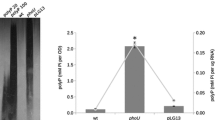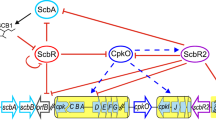Summary
Pyocyanin was produced only after the exponential phase of growth on all media examined. Pyocyanin was also found to be produced in response to some nutrient limitation (for example, carbon or oxygen). Furthermore, by controlling the growth rate at less than approximately 0.1 h−1 the repression of pyocyanin production could be overcome to a large degree. An inverse relationship existed at low growth rates between growth rate and pyocyanin production, with a decrease in growth rate resulting in increased pyocyanin levels.
Therefore, pyocyanin production appeared to be regulated by the energy status of the cell which would be lowered under conditions of low nutrient concentration, resulting in a decrease in growth rate and an increase in the level of pyocyanin produced. Under conditions of readily available nutrients the energy generating capacity of the cell was increased resulting in an increased growth rate and repression of pyocyanin.
The ability of uncouplers of oxidative phosphorylation (e.g. CCCP and FCCP) to induce pyocyanin production, and of inhibitors of the membrane-bound ATPase (e.g. DCCD and sodium azide) to repress pyocyanin production, confirmed the existance of an energy mediated regulatory mechanism. Indeed, the evidence presented here along with the reported regulatory role of inorganic phosphate in pyocyanin production, suggests that production of this antibiotic may be regulated by intracellular ATP levels.
Similar content being viewed by others
References
Byng GS, Eustice DC, Jensen RA (1979) Biosynthesis of phenazine pigments in mutant and wild-type cultures of Pseudomonas aeruginosa. J Bacteriol 138:846–852
Frank LH, DeMoss RD (1959) On the biosynthesis of pyocyanine. J Bacteriol 77:776–782
Heytler PG (1979) Uncouplers of oxidative phosphorylation. Methods Enzymol 55:462:472
Ingledew WM, Campbell JJR (1969) A new resuspension medium for pyocyanine production. Can J Microbiol 15:595–598
Ingram JM, Blackwood AC (1970) Microbial production of phenazines. Advances in Appl Microbiol 13:267–282
Janglova Z, Suchy J, Vanek Z (1969) Regulation of biosynthesis of secondary metabolites. VII. Intracellular ATP concentration in Streptomyces aureofaciens. Folia Microbiol 14:208–210
King EO, Ward MK, Raney DE (1954) Two simple media for the determination of pyocyanine and fluorescein. J Lab Clin Med 44:301–307
Kurachi M (1958) Studies on the biosynthesis of pyocyanine. 1. On the cultural conditions for pyocyanine formation. Bull Inst Chem Res Kyoto Univ 36:163–173
Leisinger T, Margraff R (1979) Secondary metabolites of the fluorescent pseudomonads. Microbiol Rev 43:422–442
Liras P, Villanueva JR, Martin JF (2977) Sequential expression of macromolecule biosynthesis and candicidin formation in Streptomyces griseus. J Gen Microbiol 102:269–277
MacDonald JC (1963) Biosynthesis of pyocyanine. Can J Microbiol 9:809–819
MacDonald JC (1967) Pyocyanine. In: Gottlieb D, Shaw PD (eds) Antibiotics II. Biosynthesis. Springer, Berlin Heidelberg New York, p 52–65
Martin JC (1976) Phosphate regulation of gene expression in candicidin biosynthesis. In: Schlesinger D (ed) Microbiology. American Society for Microbiology, Washington DC, p 548–552
Martin JF (1977) Control of antibiotic synthesis by phosphate. Adv Biochem Eng 6:105–127
Martin JF, Demain AL (1976) Control by phosphate of candicidin production. Biochem Biophys Res Commun 71:1103–1109
Martin JF, Demain AL (1977a) Cleavage of adenosine 5′-monophosphate during uptake by Streptomyces griseus. J Bacteriol 132:590–595
Martin JF, Demain AL (1977b) Effect of exogenous nucleotides on the candicidin fermentation. Can J Microbiol 23:1334–1339
Martin JF, Demain AL (1980) Control of antibiotic synthesis. Microbiol Rev 44:230–251
Martin JF, Liras P, Demain AL (1978) ATP and adenylate energy charge during phosphate-mediated control of antibiotic synthesis. Biochem Biophys Res Commun 83:822–828
Palumbo SA (1972) Role of iron and sulfur in pigment and slime formation by Pseudomonas aeruginosa. J Bacteriol 111:430–436
Propst C, Lubin L (1979) Light-mediated changes in pigmentation of Pseudomonas aeruginosa cultures. J Gen Microbiol 113: 261–266
Robbers JE, Robertson LW, Hornemann KM, Jindra A, Floss HG (1972) Physiological studies on ergot: further studies on the induction of alkaloid synthesis by tryptophan and its inhibition by phosphate. J Bacteriol 112:791–796
Silaeva SA, Glazer VM, Chestakov SV, Prokofiev MA (1965) Nucleotides of Bacillus brevis G.B. cells producing and non-producing gramicidin S. Biokhimiya 30:947–955
Stanier RY, Palleroni NJ, Doudoroff M (1966). The aerobic pseudomonads: a taxonomic study. J Gen Microbiol 43:159–271
Vandamme EJ, Demain AL (1976) Nutrition of Bacillus brevis ATCC 9999, the producer of gramicidin S. Antimicrob Agents Chemother 10:265–273
Von Zaltza MH, Last JA, Stapleton PG, Rathnum ML, Neidleman SL (1969) Cyanomycin, its identity with pyocyanine. J Antibiot 22:49–54
Vu-Trong K, Bhuwapathanapun S, Gray PP (1980) Metabolic regulation in tylosin-producing Streptomyces fradiae: regulatory role of adenylate nucleotide pool and enzymes involved in biosynthesis of tylonolide precursors. Antimicrob Agents Chemother 17:519–525
Vu-Trong K, Bhuwapathanapun S, Gray PP (1981) Matabolic regulation in tylosin-producing Streptomyces fradiae: phosphate control of tylosin biosynthesis. Antimicrob Agents Chemother 19:209–212
Weinberg ED (1974) Secondary metabolism: control by temperature and inorganic phosphate. Dev Ind Microbiol 15:70–81
Whooley MA, McLoughlin AJ (1982) Implication of adenine nucleotide levels in the regulation of exoprotease production by Pseudomonas aeruginosa (In Press).
Author information
Authors and Affiliations
Rights and permissions
About this article
Cite this article
Whooley, M.A., McLoughlin, A.J. The regulation of pyocyanin production in Pseudomonas aeruginosa . European J. Appl. Microbiol. Biotechnol. 15, 161–166 (1982). https://doi.org/10.1007/BF00511241
Received:
Issue Date:
DOI: https://doi.org/10.1007/BF00511241




